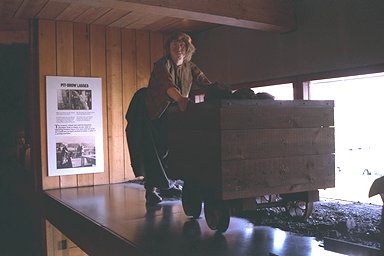 English clogs or
wooden-soled shoes were primarily worn by underground coal miners, other pit workers such
as the 'pit brow lasses' who worked on the surface hand-grading lumps of coal or pushing
the loaded coal wagons between the colliery buildings, and by the many thousands of cotton
mill workers in the 1800s and early 1900s.
English clogs or
wooden-soled shoes were primarily worn by underground coal miners, other pit workers such
as the 'pit brow lasses' who worked on the surface hand-grading lumps of coal or pushing
the loaded coal wagons between the colliery buildings, and by the many thousands of cotton
mill workers in the 1800s and early 1900s.
Indeed wherever it was damp or wet underfoot, clogs were the preferred
footwear due to their cheapness (to buy and to repair), their long-lasting wear, and their
comfort. 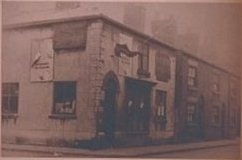 But they always were (and still are) associated with the abject
poverty endemic in the industrial towns of the North of England of the 19'th c.
But they always were (and still are) associated with the abject
poverty endemic in the industrial towns of the North of England of the 19'th c.
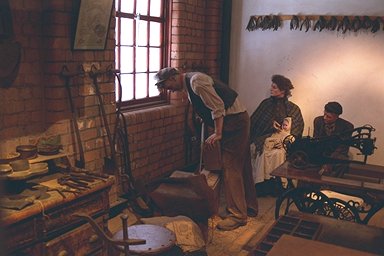 "My
grandad started it off in 1898, when he was 26 ... I think his first week's takings were
thirty bob." [That was 30 shillings or 30s 0d = £1.50 today].
"My
grandad started it off in 1898, when he was 26 ... I think his first week's takings were
thirty bob." [That was 30 shillings or 30s 0d = £1.50 today].
"Grandad" was Walter Hurst of Hindley, who later had six
cloggers and a shoe repairer working for him. Most cloggers were one-man businesses
working from the front room of their houses.
"The price of a pair of size 8 pit clogs was 3s 2d." [That
is about 16p today.] "The profit on this was 5½d." [That's
about 2p today].
"They might have had a best pair of clogs or a pair of night or
'neet' clogs as they say round here, which were fancy pattern clogs."

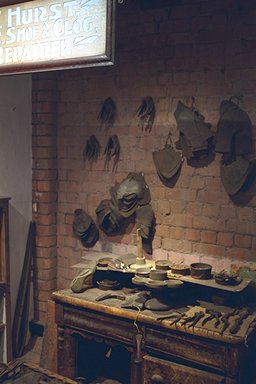 Clog
Making
Clog
Making
"Everything from start to finish was made on the premises. The things which
were not made on the premises were clog irons, clog rubbers, and nails. Everything else
was made here."
"It took two hours to make the sole and a further two hours to make the
uppers. The uppers were cowhide, the soles alder." [Now-a-days beech is used
which is inferior because it tends to split.]
"The wood first came from Wales. It came in blocks ... and these were brought
to Hindley North Station and were brought down by carrier ... these blocks were stored to
season ... they were all moved round about and the ones nearest the door were used, they
probably had them two or three years by then."
"The irons were made at Atherton ... a chap called Jim Naylor ... Naylor's
Ironworks at Atherton."
Dancing clogs were termed 'neet' clogs, they did not have irons or rubbers
on the soles and were lighter than the heavier working clogs. The uppers were usually
highly tooled (decorated) and often coloured.

Up and Down Fighting
Clog fighting, locally called 'purring' was a means of settling disputes. Both the
fighting and the betting among spectators was illegal.
"It is all up and down fighting here. They fought quite naked, excepting their
clogs. When one has the other down on the ground he first endeavours to choke him by
squeezing his throat, then he kicks him on the head with his clogs. Sometimes they are
very severely injured."

Clog Dancing
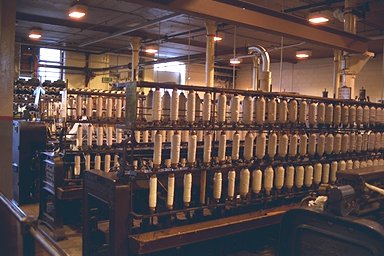 Lancashire
is known for its clog dancing all over the world. Cotton mill workers could emulate the
sound of the cotton looms with their clogs. Miners partook of formal dance competitions at
the working men's clubs for small monetary prizes. Afterwards the winner usually then had
to fight the losers to keep his prize! National competitions such as the World Clog
Dancing Championships were keenly attended and the winner went away with a handsomely
tooled leather belt and probably a large monetary prize.
Lancashire
is known for its clog dancing all over the world. Cotton mill workers could emulate the
sound of the cotton looms with their clogs. Miners partook of formal dance competitions at
the working men's clubs for small monetary prizes. Afterwards the winner usually then had
to fight the losers to keep his prize! National competitions such as the World Clog
Dancing Championships were keenly attended and the winner went away with a handsomely
tooled leather belt and probably a large monetary prize.
Street corner dancing was the entertainment of the day. Indeed clog and
step dancing was THE most popular form of home entertainment in the 1800s.
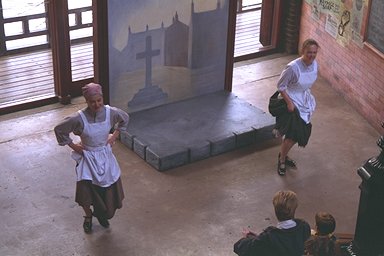 The predominant style of Lancashire clog dancing was
termed 'heel and toe.' Many of the steps emulate the sound of the shuttle and other partsd
of the cottom spinning and weaving machinery. Also with the influx of thousands of Irish
immigrants into the mills and factories another hybrid style of dancing also evolved
called 'Lancashire-Irish.' Pat Tracey was an expert Lancashire 'Heel & Toe' clog
dancer having learnt many steps from various members of her family. She was also an expert
'Irish-Lancashire' clog dancer. With Barry Callaghan's 'Garland Films' she has produced
many instructional videos - see: Videos, Tapes & Books.
The predominant style of Lancashire clog dancing was
termed 'heel and toe.' Many of the steps emulate the sound of the shuttle and other partsd
of the cottom spinning and weaving machinery. Also with the influx of thousands of Irish
immigrants into the mills and factories another hybrid style of dancing also evolved
called 'Lancashire-Irish.' Pat Tracey was an expert Lancashire 'Heel & Toe' clog
dancer having learnt many steps from various members of her family. She was also an expert
'Irish-Lancashire' clog dancer. With Barry Callaghan's 'Garland Films' she has produced
many instructional videos - see: Videos, Tapes & Books.
Exponents of clog dancing would often become professional music hall
dancers as a route out of the poverty and squalor of living in the crowded and polluted
mill towns of that time.
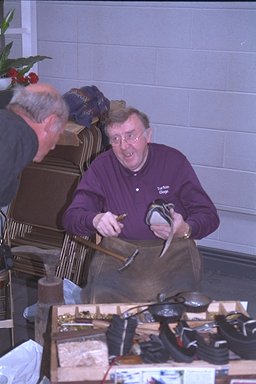 One
notable Lancashire clog dancer who ultimately succeeded was of course Charlie Chaplin who
performed in a troupe called the 'Seven Lancashire Lads,' he was but one of many
hundreds of professional clog dancers. In his early days the great Dan Leno was also
a World Champion clog dancer, and other professional and amateur dancers would attend his
every performance to try and learn his steps. Indeed is has been reported that most music
hall artists had a clog dance in his/her repertory and that if his/her act was failing to
entertain a rowdy audience then breaking into a clog dance could often 'save' the act.
One
notable Lancashire clog dancer who ultimately succeeded was of course Charlie Chaplin who
performed in a troupe called the 'Seven Lancashire Lads,' he was but one of many
hundreds of professional clog dancers. In his early days the great Dan Leno was also
a World Champion clog dancer, and other professional and amateur dancers would attend his
every performance to try and learn his steps. Indeed is has been reported that most music
hall artists had a clog dance in his/her repertory and that if his/her act was failing to
entertain a rowdy audience then breaking into a clog dance could often 'save' the act.
These music hall clog dancers took stage clog dancing not only to the
U.S.A. but also to Canada, Australia and New Zealand - for the summer season in both
hemisperes. And in the U.S.A. stage clog dancing (with wooden-soled shoes) took on a
tradition all of its own with many wooden-soled shoe dancers even publishing their own
instructional manuals such as: Dick Sands, Henry Tucker, and Ed. James, to name but a
few.
It appears that Lancashire clog dancing was also taken to the USA via the
cotton mill industry - see: Tony Barrand's web site on the 'Dancing Marleys'.
Yet another more unstructured style of dancing came from the canal folk
who worked the wide boats on the Leeds and Liverpool Canal and who 'danced' in time to the
single stroke bolinder engine. Bill Gibbons was the last canal boat dancer. It was said
that the canal boat-people were the better dancers and nearly always won the informal
dance competitions in the canal-side pubs of an evening. Apparently step dancing on a
table on which were placed pints of ale was one 'trick' to demonstrate the expertese of
the performer. The idea was - of course - not to spill the ale or to knock the pint pots
onto the floor. (Reference: 'Journey into England' by John Seymour).

True English (and Scottish and Welsh) clog dancing is still enjoyed by
many enthusiasts around the world, many having been taught by traditional dancers such as
Pat Tracey, Sam Sherry, Sammy Bell, Bert Bowden and the Ellwood family, to name but a few.
Unfortunately there are only a very small number of clog makers left from the many hundreds
who traded in the late 1800s and early 1900s. Cloggers still trading include Trefor Owen, the Turtons (see picture), Jerry Atkinson, Walter Hurst, and Walkleys.
There are however many old and modern films and videos of clog makers and
clog dancers, and these are listed here: Videos, Tapes & Books.
For information on clog making see: Clog Making.

Lancashire Dialect
No page about Lancashire clogging would be complete without some poetry in
the clipped dialect which evolved in the noisy environment of the 19'th c. cotton looms.
From:
http://www.ex-lancs.com/lancashire_poetry.htm
IT DIDN’T SEEM
REET - Anon.
Wen a fella cum walkin’ deawn eawr road,
‘Is clogs went "er—clatt, er—clatt."
An’ it struck mi, as Ah’d never knowed
A pair o’clogs t’seawnd like that.
Soo Ah waited wile ‘ee getten close,
Fer t’see wot wer th’matter,
Clogs doant "er—clatt, er—clatt" tha knows
Thi should guh "clatt—er, clatt—er!"
Ah thowt, "Just wen ‘as passes mi
Ah’ll ‘ev a looka’t’greawnd,
Cause Ah wer fair reet wonderin’
O’er th’reason feryon seawnd.
Sos wen ‘ee sad, "Nah then theer,"
Wen ‘ee passed mii’ th’ street,
Ah looked, an’ does ta know
Booath ‘is clogs wero’t’wrong feet. |
THE CLOG MAKER - Anon.
Young Jim he were a clogger, Wi'a workshop, up some steps.
Ther'l be lots o'folk a warin, those fancy clogs'e meks.
'e cuts the soles from wooden blocks, wi a fancy shaped machine,
An clever folk'ave coed it, A clogger's guillotin
An when e’s finished shapen' soles, An tacked'is leather round,
'e's ready then fer buckle on, An pattin'toe-caps down.
A can see'im now a shapin' Some very pointed soles,
'e sez ther for a clog-dancer, 'who puts on special shows.
An'then thers bread and butter clogs, which Jim meks by the score,
An'when ther blacked and polished up, Ther ready for the store.
But one thing's sure, ther is no doubt, For warin on yer feet.
Yo canna beat Jims wooden clogs, becoz ther med just reet. |
![]()
![]()
![]()